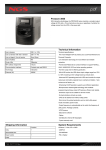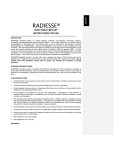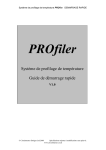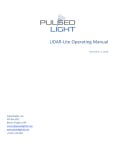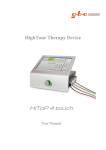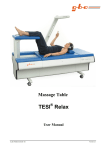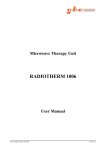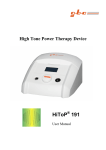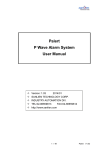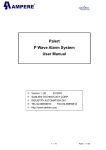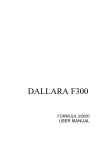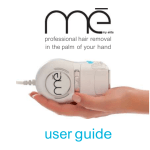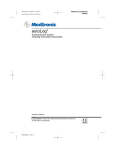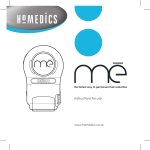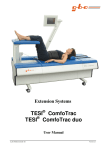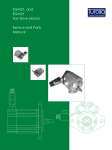Download ProWave 770 Handpiece Operator Manual--English
Transcript
ProWave 770 Handpiece Operator Manual TM ii This manual is copyrighted with all rights reserved. Under copyright laws, this manual may not be copied in whole or in part or reproduced in any other media without the express written permission of Cutera, Inc. Permitted copies must carry the same proprietary and copyright notices as were affixed to the original. Under US federal law, copying includes translations into another language. Please note that while every effort has been made to ensure that the data given in this document is accurate, the information, figures, illustrations, tables, specifications, and schematics contained herein are subject to change without notice. Cutera is the registered trademark of Cutera, Inc. Writer: Editor: Illustrator: Translator: Ken Chin Staff Ken Chin IDEM Translations, Inc. Palo Alto, California, USA ©Cutera, Inc. November 2005 Published in USA D0277 Revision B Authorized European Representative med-unlimited, Regulatory Management Solutions GMBH Kleiststrasse 2, D-45128 Essen, Germany PROWAVE 770™ HANDPIECE OPERATOR MANUAL D0277, REV. B 11/05 iii C ONTENTS OPERATION 1 Introduction 1 Console Preparation 2 Preparing the ProWave 770 Handpiece 3 Inspect the ProWave 770 Handpiece 3 Connect the ProWave 770 Handpiece 3 System Basics 6 Functions of the ProWave 770 Handpiece 6 ProWave 770: Select Screen 7 ProWave 770 Handpiece and System Status: Ready and Standby Mode 8 Display and Indicators 10 Number of Remaining Exposures Indicator 11 Selecting Parameters for the ProWave 770 Handpiece 12 A, B and C Program Modes 12 Fluence 13 Repetition Rate 14 Snowflake Mode 15 MAINTENANCE 17 Troubleshooting Guide 17 User Maintenance 20 Annual System Maintenance 20 Clean the ProWave 770 Handpiece 20 PROWAVE 770™ HANDPIECE OPERATOR MANUAL D0277, REV. B 11/05 iv Specifications for the ProWave 770 Handpiece 22 Treatment Beam 22 Physical Parameters 23 Environmental Requirements 23 Classifications 23 Calibration Procedure 24 Equipment Required 25 Calibration Verification Instructions 25 Warranty Information 26 SAFETY AND REGULATORY 27 Introduction 27 Optical Hazard 28 Eye Wear Specifications 30 Additional Ocular Protection 32 Additional Safety Considerations 33 Protecting Non-target Tissues 33 Electrical Hazard 34 Fire Hazard 35 Regulatory Compliance 35 Location of Controls 36 Key Lock Switch 36 Emergency Off Push-Button 36 Emission Indicator 36 Remote Interlock 37 Protective Housing 37 Audible Emission Indicator 37 Manual Reset 38 Electronic Fault Detection Circuitry 38 Operational Training 39 Operational Safety 39 Location of Regulatory Compliance Labels 41 PROWAVE 770™ HANDPIECE OPERATOR MANUAL D0277, REV. B 11/05 v CLINICAL APPLICATION 43 General Indications for Use 43 Specific Indications 43 Contraindications for Use 44 Precautions 44 Expected Transient Events and Possible Adverse Effects 45 Treatments Precautions 45 Treatments 46 Patient Information 47 Treatment Information for Hair Removal 47 APPENDIX A - LASER WARNING SIGN APPENDIX B - SYMBOLS APPENDIX C - BIBLIOGRAPHY APPENDIX D - CUTERA DIRECT OFFICE LOCATIONS PROWAVE 770™ HANDPIECE OPERATOR MANUAL D0277, REV. B 11/05 vi THIS PAGE IS LEFT BLANK PROWAVE 770™ HANDPIECE OPERATOR MANUAL D0277, REV. B 11/05 1 Operation Introduction Cutera™ aesthetic platforms include a variety of laser and non-laser light sources to perform various dermatologic treatments. Cutera console architecture allows owners to add new user-installable handpieces as new applications and technologies are developed. This operator manual describes the ProWave 770™ handpiece, its use and operation in conjunction with compatible consoles, which include the CoolGlide® Xeo, Xeo SA and the Solera Opus™ consoles. The modular nature of Cutera Xeo and Solera systems, and the handpieces are accompanied by a similar modular structure for the associated operator manuals. Two separate operator manuals are required for any Cutera console used in combination with any user-detachable Cutera handpiece. The primary operator manual describes the use and operation of the console, while a companion operator manual describes the use, operation, and general indications for a specific handpiece. The ProWave 770 Operator Manual is the companion Operator Manual that describes the use and operation of the ProWave 770 handpiece. The CoolGlide Xeo, Xeo SA, and the Solera Opus consoles are described in detail in their respective primary operator manuals. Please refer to primary operator manual D0075 for information regarding CoolGlide Xeo PROWAVE 770™ HANDPIECE OPERATOR MANUAL D0277, REV. B 11/05 2 systems, and primary operator manual D0249 for information regarding the Solera Opus system. Users should read and understand the appropriate primary and companion operator manuals for their particular console and handpiece combination. The ProWave 770 handpiece in combination with a compatible Cutera console, when handled and operated properly, comprises a useful and reliable medical instrument. If after reviewing this companion operator manual you have further questions regarding the ProWave 770 handpiece, contact your local Cutera representative. WARNING Any pulsed-light emitting device can generate highly concentrated light which may cause injury if improperly used. To protect patients and operating personnel, the entire appropriate console primary operator manual, including the Safety and Regulatory sections, should be carefully read and comprehended before operation. Additionally, the companion operator manual associated with a particular handpiece, such as the ProWave 770 handpiece, should also be read and understood prior to use. Console Preparation Your ProWave 770 compatible Cutera console should be fully operational prior to attempting to install or use the ProWave 770 handpiece. Please refer to the appropriate console primary operator manual for details of system preparation. PROWAVE 770™ HANDPIECE OPERATOR MANUAL D0277, REV. B 11/05 3 Preparing the ProWave 770 Handpiece Inspect the ProWave 770 Handpiece Before connecting the ProWave 770 handpiece, inspect the handpiece connector, umbilical cable, handpiece housing, and patient contact surface for any dirt, debris, or damage. WARNING In the event that the handpiece under inspection is connected to the console, verify that the system power is OFF. Never look directly into the emitted light or at scattered light from metallic or other reflective surfaces. The ProWave 770 handpiece operated with an appropriate Cutera console can cause eye or skin damage. Inspect the pins inside the handpiece connector. Ensure the pins are not damaged, bent or recessed. Connect the ProWave 770 Handpiece Before connecting the ProWave 770 handpiece, be sure the handpiece resting assembly is installed in its mounting mechanism and locked into place. On Xeo consoles, it is part of the handle assembly. On the Solera platform, it is part of the console. If your console has a sensor cable, plug the handpiece resting assembly sensing plug into the mating receptacle at the top right-hand corner of the rear panel cover. Refer to the appropriate primary operator manual for further information. 1. Disconnect the main system electrical power. PROWAVE 770™ HANDPIECE OPERATOR MANUAL D0277, REV. B 11/05 4 WARNING Do not attempt to disconnect the ProWave 770 handpiece while the system is ON. The handpiece connector should be easily and smoothly removed without requiring significant force. 2. Place the ProWave 770 handpiece on the appropriate location on the handpiece tree. Once the ProWave 770 handpiece is properly resting in the tree, route the umbilical so it does not encumber the operator or patient. PROWAVE 770™ HANDPIECE OPERATOR MANUAL D0277, REV. B 11/05 5 CoolGlide Xeo Xeo SA Solera Opus 3. Align the connector over the mating connector located in the top panel. 4. Press the grey buttons in firmly, ensuring that the water connection mechanisms are latched in the open position. PROWAVE 770™ HANDPIECE OPERATOR MANUAL D0277, REV. B 11/05 6 5. Press the connector downwards gently to align the fittings. Once aligned, press the connector downwards firmly. NOTE It is important to always listen for two audible clicks when installing the ProWave 770 handpiece. Proper handpiece engagement only occurs when both clicks are heard. 6. Reconnect the main system electrical power. System Basics Please refer to the appropriate primary operator manual for system basic operation. Functions of the ProWave 770 Handpiece Only those functions specific to the ProWave 770 handpiece are described in this companion operator manual. Console functions are described in the appropriate primary operator manuals. For general console functions, or for functions associated with other Cutera handpiece models, please refer to the appropriate primary or companion operator manual. PROWAVE 770™ HANDPIECE OPERATOR MANUAL D0277, REV. B 11/05 7 ProWave 770: Select Screen After the console has been turned ON and the system self-test has been completed, the Select Screen is displayed, and the system is automatically placed in STANDBY mode. In STANDBY, the footswitch is disabled and no treatment light energy is available. ProWave 770 Select Screen (for the Solera Opus console) PROWAVE 770™ HANDPIECE OPERATOR MANUAL D0277, REV. B 11/05 8 ProWave 770 Handpiece and System Status: Ready and Standby Mode The handpiece Control Screen is accessed by simply pressing the handpiece icon. The Control Screen allows for the • Monitoring • Control of the system status • Selection of all user-selectable treatment parameters READY mode can be accessed from the Control Screen by selecting the green button located at the touch screen lower right corner. READY mode is indicated by a green color, which highlights the J/cm2 button, the Hz button, and the READY button itself, on the touchscreen. For some consoles, it is necessary to remove the handpiece from the handpiece resting assembly before READY mode can be accessed. ProWave 770 STANDBY Mode PROWAVE 770™ HANDPIECE OPERATOR MANUAL D0277, REV. B 11/05 ProWave 770 READY Mode 9 In READY mode, the footswitch is enabled and pressing the footswitch produces a treatment light exposure from the ProWave 770 handpiece. The system will emit an audible tone to indicate emission with each pulse. Except during actual treatment, the system may be placed in STANDBY mode at any time by pressing the yellow button in the Control Screen located at the touch screen lower left corner. If the console is not used for three minutes, the system will automatically transition to STANDBY mode. NOTE There is no aiming beam available for the ProWave 770 handpiece. WARNING Except during actual treatment, the system must always be in STANDBY mode. Maintaining the system in STANDBY mode prevents accidental treatment beam exposure if the footswitch is inadvertently pressed. WARNING Verify that all persons in the treatment room are wearing appropriate treatment beam safety eyewear before placing the system in READY mode. PROWAVE 770™ HANDPIECE OPERATOR MANUAL D0277, REV. B 11/05 10 Displays and Indicators The ProWave 770 handpiece and compatible consoles use various indicators and controls to ensure safe and accurate operation. • A Shot Counter display including a Shot Counter Reset button. The console records and displays the total number of treatment pulses (in all modes) produced since the last button reset. • An Emissions Indicator. The Emissions Indicator will illuminate when the system is in READY mode, and the footswitch is pressed. • A Back button. The Back button returns the display from the Control Screen to the Select screen or from the Information Screen to the Select Screen. Back Button Emissions Indicator Shot Counter Reset Button Shot Counter ProWave 770 Control Screen PROWAVE 770™ HANDPIECE OPERATOR MANUAL D0277, REV. B 11/05 11 Number of Remaining Exposures Indicator Prowave 770 handpieces are designed to maximize the amount of treatment light exposures available. However, the ProWave 770 does have a limited life. When the limit on the number of treatment exposures that the handpiece is designed to reliably deliver is reached, the Control Screen is replaced with a large indicator representing the fact that no further exposures are possible with the handpiece. When this indicator is displayed, the handpiece must be reconditioned before it can be used again. A warning indicator is temporarily displayed when the handpiece treatment exposure limit is approaching. Contact your local Cutera office for replacement or reconditioning. PROWAVE 770™ HANDPIECE OPERATOR MANUAL D0277, REV. B 11/05 12 Selecting Parameters for the ProWave 770 Handpiece The ProWave 770 Control Screen must be accessed to select or view parameters for the ProWave 770 handpiece. In the Select Screen, press the ProWave 770 icon to reach the ProWave 770 Control Screen. A, B and C Program Modes Selecting the Program Mode determines the combination of pulsed-light wavelength distribution, pulse duration and contact window temperature used for a particular treatment. “A” mode is associated with having the shortest wavelength, while “B” and “C” modes have intermediate and long wavelength distributions, respectively. • “A” mode is also associated with a pulsed-light having a wavelength distribution weighted towards the shortest wavelengths. “A” is also associated with the least amount of epidermal cooling. • ”B” mode has an intermediate pulse duration and therefore, has an intermediate wavelength distribution. “B” mode is also associated with intermediate epidermal cooling. • “C” mode has a long pulse duration and therefore, has a long wavelength distribution. “C” mode is also associated with requiring strong epidermal cooling Each of the three Program Modes may be selected by simply pressing “A”, “B” or “C” buttons located in the center of the Control Screen. PROWAVE 770™ HANDPIECE OPERATOR MANUAL D0277, REV. B 11/05 13 Program Mode Buttons Select Between the Three Program Modes for the ProWave 770 When the Program Mode is changed, the fluence and repetition rate are changed to the most recent settings used with that Program Mode selection. Verify that the fluence and repetition rate for the new Program Mode selection are correct and adjust as necessary. Fluence Fluence is defined as the delivered optical energy per unit area at the treatment site and is expressed in Joules per square centimeter (J/cm2). Select the desired fluence by pushing the UP/DN buttons located below the J/cm2 display. PROWAVE 770™ HANDPIECE OPERATOR MANUAL D0277, REV. B 11/05 14 NOTE Since the fluence and repetition rate can change after a Program Mode selection, adjust or verify the fluence after each Program Mode change. Fluence UP/DN buttons Set the Fluence for the ProWave 770 Handpiece Repetition Rate The repetition rate allows you to specify the speed or rate at which you work. The repetition rate is defined as the number of treatment pulses delivered per second and is expressed in units of Hertz (Hz). Select the desired repetition rate by pushing the UP/DN buttons located below the Hz display. PROWAVE 770™ HANDPIECE OPERATOR MANUAL D0277, REV. B 11/05 15 NOTE Since the fluence and repetition rate can change after a Program Mode selection, adjust or verify the repetition rate after each Program Mode change. Repetition Rate UP/DN button Set the Repetition Rate for the ProWave 770 Handpiece Snowflake Mode The contact window temperature is determined by the Program Mode selected, with Program Mode “C” having the coldest contact window temperature. When Snowflake Mode is selected, the contact window temperature is set to a fixed temperature, independent of the Program Mode selected. This temperature is colder than the standard settings for each Program Mode. See Specifications section for more information. PROWAVE 770™ HANDPIECE OPERATOR MANUAL D0277, REV. B 11/05 16 ProWave 770 in Standby Mode Snowflake Control Button ProWave 770 in Ready Mode PROWAVE 770™ HANDPIECE OPERATOR MANUAL D0277, REV. B 11/05 17 Maintenance Troubleshooting Guide The troubleshooting guide in this companion operator manual contains troubleshooting information specific to the ProWave 770 handpiece. This troubleshooting guide consists of a list of common problems specific to the ProWave 770 handpiece, and some potential solutions. Use this guide to solve problems with your ProWave 770 handpiece. For specific information on problems associated with your Cutera console, please refer to the troubleshooting guide located in the Maintenance Section of the appropriate primary operator manual for your console. Before proceeding with the troubleshooting guide, please check the following: 1. Electrical power source. Verify that the electrical disconnect switch (the circuit breaker) is turned on (in the UP position). PROWAVE 770™ HANDPIECE OPERATOR MANUAL D0277, REV. B 11/05 18 2. System console electrical. Verify that the system is on and properly connected to an electrical service outlet. 3. Handpiece connection. Verify that the handpiece is properly connected. If your console is a Xeo, be sure that the handpieces are properly parked on the handpiece resting assembly. If unsure, turn off the system, disconnect and reconnect the handpiece umbilical, listening for two audible clicks. 4. Remote Interlock. If the Remote Interlock plug is used in conjunction with a door switch, verify that the Remote Interlock plug is inserted in the Remote Interlock receptacle. Close the interlock door. Console will not complete system self-test or display the Select Screen. Probable Cause: Suggestion: Handpiece not properly connected. Unplug and reconnect the handpiece. Low or no energy output (patient reports no sensation). Probable Cause: Suggestion: The window on the ProWave 770 handpiece is damaged or contaminated. Unplug and replace the handpiece. Probable Cause: Suggestion: Incorrect fluence selection or treatment technique. Refer to the Clinical Guidelines. Control Screen displays “no shots remaining” icon. Probable Cause: Suggestion: PROWAVE 770™ HANDPIECE OPERATOR MANUAL D0277, REV. B 11/05 Lifetime number of treatment pulses has been reached. Unplug and replace the handpiece. 19 Fault 339 appears during treatment. Probable Cause: Suggestion: Optical failure in the handpiece. Unplug and replace the handpiece. Console will not enter READY mode - displays faults 246 and 367. Probable Cause: Suggestion: Handpiece lamp failure. Replace the handpiece. Console will not enter READY mode - green READY button “spins”. Probable Cause: Suggestion: Handpiece temperature control fault. Replace the handpiece. PROWAVE 770™ HANDPIECE OPERATOR MANUAL D0277, REV. B 11/05 20 User Maintenance Annual System Maintenance Preventive maintenance, safety, power, and calibration checks should be performed annually by a Cutera representative to ensure proper performance. Refer to the appropriate primary operator manual for detailed information on system maintenance. Clean the ProWave 770 Handpiece WARNING Never look into the ProWave 770 handpiece while the system is in READY mode. CAUTION Do not attempt to sterilize any Cutera handpiece. Damage will occur if the ProWave 770 handpiece is autoclaved, immersed or otherwise handled improperly. 1. Inspect the ProWave 770 handpiece window for any debris. 2. Disinfect the handpiece window. PROWAVE 770™ HANDPIECE OPERATOR MANUAL D0277, REV. B 11/05 21 Inspect the ProWave 770 handpiece window for debris. The window should be disinfected between each patient use. The ProWave 770 handpiece window should be disinfected between uses on patients using a germicidal disposable wipe, (such as Sani-Cloth® Plus or Sani-Cloth® HB from Professional Disposables, Inc.). WARNING Before disinfecting the ProWave 770 handpiece window, make certain the system is either turned OFF or in STANDBY mode. Always wear proper protective eye wear while the system is ON. Eye injury can occur in the event of unintended pulsed-light emission. 3. Inspect and clean the window regularly, during each case and after every case. NOTE If debris cannot be removed after repeated cleaning, disconnect/replace the ProWave 770 handpiece and contact your local Cutera service representative. PROWAVE 770™ HANDPIECE OPERATOR MANUAL D0277, REV. B 11/05 22 Specifications for the ProWave 770 Handpiece Specifications subject to change without notice. Treatment Beam Pulsed-Light Type Pulsed Light source Wavelength 770 - 1100 nm Output 150 J Max. Fluence <50 J/cm2 Exposure Duration automatic Repetition Rate Single shot to 2 Hz Delivery System User detachable umbilical cable and handpiece Treatment Spot 1.0 cm x 3.0 cm rectangular contact area Epidermal Cooling Sapphire contact window actively maintains epidermal temperature at 3 fixed points depending on Program Mode selected. Range is 10° C to 25° C. Snowflake Mode overrides the Program Mode setting with a fixed contact window temperature (5° C) PROWAVE 770™ HANDPIECE OPERATOR MANUAL D0277, REV. B 11/05 23 Physical Parameters Handpiece Weight: 0.7 lbs. (.3 kg.) Operating length of umbilical: 7 ft. (2 m) Minimum bend radius of umbilical: Storage Momentary 5 in. (126 mm) 2 in (50 mm) Temperature: Operating Storage -5º C to 27º C -10º C to 50º C Humidity: 0 to 90%, non-condensing Environmental Requirements Classifications FDA Classification Class II Medical Device European MDD 93/42/EEC PROWAVE 770™ HANDPIECE OPERATOR MANUAL D0277, REV. B 11/05 24 Calibration Procedure Regulatory agencies require that manufacturers of US FDA CDRH Class III and IV, and European EN 60825 Class 3 and 4 medical lasers supply their customers with power calibration instructions. While the ProWave 770 handpiece is not a laser, and customers are not able to alter the calibration of the ProWave 770 handpiece, instructions for verifying proper calibration are included here. Calibration of the ProWave 770 handpiece optical output should be checked periodically. With proper care under normal operating conditions, Cutera recommends checking the calibration every twelve (12) months to ensure that the energy output delivered from the handpiece corresponds accurately to the userselected settings. The following procedure should also be performed after any service or repair work. DISCLAIMER WARNING Adjustment or alteration of the ProWave 770 handpiece is a service procedure to be performed only by a Cuteracertified Service Engineer or at the Cutera factory. Adjustments by anyone other than a trained Cutera Service Engineer voids any existing manufacturer’s warranty on the instrument. A service manual for your appropriate console platform may be purchased from the Cutera Service Department, however, possession of service instructions or service tooling does not authorize repair or modification of a Cutera system by uncertified personnel. Calibration must be performed by an engineer or technician certified to work on energized electronic laser and pulsed-light equipment. Questions regarding this procedure should be referred to your local Cutera representative. PROWAVE 770™ HANDPIECE OPERATOR MANUAL D0277, REV. B 11/05 25 Equipment Required Laser energy meter (Ophir Nova display unit model with L40-150A-SH sensor). The meter used must have received a NIST-traceable calibration within the past 12 months (in the US) or a calibration conforming to the applicable standard (internationally). Calibration Verification Instructions CAUTION Any work performed by unauthorized personnel will void all warranties. 1. Set up the laser energy meter in a convenient location so that the sensor head can be easily reached with the ProWave 770 handpiece and set the meter display unit to the ENERGY mode. 2. Place the ProWave 770 handpiece tip in front of the energy meter sensor head. NOTE The distance must be no further than 2 mm from the energy meter, and the sapphire window should be centered on the energy meter aperture. 3. Ensure that the handpiece is connected to a ProWave 770 compatible Cutera console, and start the console. 4. Verify that the laser energy meter wavelength range is 0.8-6.0 microns. 5. Select “A” mode and the lowest fluence setting available. 6. Place the system in READY mode and fire a single shot into the energy meter. PROWAVE 770™ HANDPIECE OPERATOR MANUAL D0277, REV. B 11/05 26 7. Record the reading on the energy meter and the user-selected fluence from the console touchscreen. 8. Repeat steps 6 and 7 for the highest fluence setting available. 9. Repeat steps 5-8 for “B” and “C” modes. The result should be a list of pairs of fluence settings and laser energy meter measurements. 10. Multiply all of the energy meter readings by a factor of 0.33. The resulting numbers correspond to the optical fluence delivered to the skin. 11. Compare the list of optical fluences delivered to skin to the list of corresponding user-selected fluences. Verify that the optical fluences delivered to the skin are within 10% of the corresponding user-selected fluences. Warranty Information For specific and detailed warranty information for your Cutera console platform, please refer to the first page of your purchase “Agreement” and the last page of the “Terms and Conditions of Sale”. PROWAVE 770™ HANDPIECE OPERATOR MANUAL D0277, REV. B 11/05 27 Safety and Regulatory Introduction The Cutera ProWave 770 handpiece and compatible Cutera aesthetic platforms, when properly used by trained personnel, are safe and effective instruments for indicated clinical treatments. Keep in mind that safe operation requires a thorough understanding of the system and safety features as described in this companion operator manual for the handpiece and the appropriate primary operator manual for the console. Users must take precautions to prevent exposure of pulsed-light energy to the eyes and skin from either direct or diffusely reflected light, except as a therapeutic application. Additional precautions must be taken to prevent fire, electrical injury, and explosion. PROWAVE 770™ HANDPIECE OPERATOR MANUAL D0277, REV. B 11/05 28 Cutera does not make recommendations regarding the practice of medicine. Pulsedlight treatment information is provided as a guide. Individual treatments should be based on clinical training, clinical observation of pulsed-light tissue interaction, and appropriate clinical endpoints. Optical Hazard Safety eyewear is routinely required with most lasers and pulsed-light systems. Personnel responsible for laser safety should determine the need for safety eyewear based on the Maximum Permissible Exposure (MPE), Nominal Hazard Zone (NHZ), the Nominal Ocular Hazard Distance (NOHD), and the optical density (OD) for each of the available laser or pulsed-light emissions and the configuration of the treatment room (usually within the controlled area). For additional information, refer to ANSI Z136.1-1993, ANSI Z136.3-1996, or European Standard EN 60825: 1992, Appendix A. The ProWave 770 handpiece and associated compatible consoles are Class II medical devices as defined by the U.S. Code of Federal Regulations and the European Communities Medical Device Directive. Laser products are typically designed using ANSI Z136.1 standards to determine appropriate eye safety wear and eye safety characteristics. The ProWave 770 handpiece is not a laser product, but rather a pulsed-light source. For the ProWave 770 and other pulsed-light handpieces, Cutera uses the ANSI Z87.1-1989 standard as a reference in the determination of the appropriate Shade Number or Filter Protection Factor for recommended eye wear. PROWAVE 770™HANDPIECE OPERATOR MANUAL D0277, REV. B 11/05 29 WARNING The pulsed-light produced by the ProWave 770 handpiece contains visible light that can also cause eye damage. Never look directly into the handpiece(s) even when wearing protective eyewear. Never look directly into the pulsed-light or at scattered light from metallic or other reflective surfaces. Both direct and reflected pulsed-light may contain sufficient energy to cause permanent eye damage. All personnel operating or located in the vicinity of a Cutera aesthetic system, including patients, staff personnel and observers, should wear appropriate protective eyewear as discussed in the Eye Wear Specifications on the next page. The eyewear should have guards on both sides to protect the eyes from lateral exposure. WARNING Never allow anyone without proper protective eyewear near the pulsed-light source while the system is in use. In addition to providing the required laser safety eyewear, take the following steps to secure the treatment room or controlled treatment area: 1. To alert personnel before they enter the controlled area, place a warning sign on the outside of the treatment room door when the system is in use. 2. Close the treatment room door during operation of the system. 3. External door interlocks that automatically disable the system when the treatment room door is opened may be installed. PROWAVE 770™ HANDPIECE OPERATOR MANUAL D0277, REV. B 11/05 30 NOTE A blocking barrier, screen, or curtain capable of blocking or filtering the pulsed-light may be placed to create a controlled area inside a large treatment room. The barrier should be made of material that can withstand the power of the treatment beam for the maximum exposure time, relative to the configuration of the controlled area and the treatment parameters for the specific medical application. The user must protect the patient’s eyes with appropriate eyewear. Eye Wear Specifications For general information on the ocular hazards associated with the ProWave 770 handpiece, please refer to the previous topic in this section. Appropriate reference standards for eye safety are: FDA Classification CDRH Classification Class II Medical Device Class IV Laser Product European MDD Laser Classification 93/42/EEC Class 4 Laser (IEC 60825:2001) In broadband pulsed light protection associated with the ProWave 770 handpiece, a protection Filter Factor* of 3 or greater is recommended. Cutera safety glasses marked with the following icons should be used with the ProWave 770 handpiece. PROWAVE 770™HANDPIECE OPERATOR MANUAL D0277, REV. B 11/05 31 * Filter Factor defined for luminous transmittance in ANSI Z87.1-1989 (R1998), Table 1. WARNING Never look directly into the ProWave 770 handpiece, even if appropriate safety eyewear is being worn. PROWAVE 770™ HANDPIECE OPERATOR MANUAL D0277, REV. B 11/05 32 Additional Ocular Protection WARNING Never substitute non-laser prescription eyewear for appropriate laser safety eyewear, as severe damage could occur. WARNING Use caution when performing procedures around the eyes. Severe and irreversible eye damage may occur from direct or indirect exposure to treatment beams. WARNING Never look directly into any optical lens, optical fiber, handpiece or pulsed-light aperture while the system is energized. Severe eye damage could occur. Turn off the system before inspecting any delivery system or laser component. PROWAVE 770™HANDPIECE OPERATOR MANUAL D0277, REV. B 11/05 33 Additional Safety Considerations WARNING Do not use this system in the presence of flammables or explosives such as anesthetics, alcohol, surgical preparation solutions, and similar substances. An explosion and/or fire could occur. CAUTION The Cutera ProWave 770 handpiece is intended solely for licensed practitioners trained in its proper use. CAUTION Use of controls or adjustments or performance of procedures other than those specified herein may result in hazardous pulsed-light radiation exposure. Protecting Non-Target Tissues WARNING Except during actual treatment, the system must always be in the STANDBY mode. Maintaining the system in the STANDBY mode prevents accidental pulsed-light exposure if the footswitch is inadvertently pressed. PROWAVE 770™ HANDPIECE OPERATOR MANUAL D0277, REV. B 11/05 34 WARNING Never place hands or other objects in the path of the ProWave 770 handpiece treatment beam. CAUTION To prevent accidental pulsed-light discharge, always turn off the system before connecting or disconnecting the ProWave 770 handpiece. Electrical Hazard • High voltages are present inside the system. Do not remove the exterior housing. • Only an authorized Cutera Service Representative should perform service on any Cutera console or handpiece. • Do not attempt to perform maintenance other than that which is outlined in this companion operator manual and the primary operator manual for the appropriate console. • Maintenance should only be performed with the system turned off and disconnected from the power source. • The system is grounded through the grounding conductor in the power cord. Grounding is essential for safe operation. PROWAVE 770™HANDPIECE OPERATOR MANUAL D0277, REV. B 11/05 35 Fire Hazard • Never use the system in a flammable environment, or near flammable substances such as alcohol or acetone. WARNING Do not use the system in the presence of oxygen, flammable anesthetics, or other flammable materials. The absorption of laser and or pulsed-light energy by a material will raise its temperature and may cause a fire and/or serious injury to personnel and equipment. • If alcohol is used to clean any part of the system, it should be allowed to dry thoroughly before using the system. Regulatory Compliance All Cutera aesthetic platforms are designed to comply with the following: • European Communities Medical Devices Directive 93/42/EEC • US Federal Performing Standards 21 CFR 1040.10 and 1040.11, IEC 60601, IEC 60601-1, IEC 60601-1-2, IEC 60601-1-4, IEC 60601-2-22, IEC 60825 and CAN/CSA 22.2 no. 601.1-M90 • 21 CFR Chapter I, Subchapter J, as administered by the Center for Device and Radiological Health of the US Food and Drug Administration (FDA) PROWAVE 770™ HANDPIECE OPERATOR MANUAL D0277, REV. B 11/05 36 CE-labeled devices comply with all appropriate performance standards as required in Annex II of the European Medical Device Directive MDD 93/42/EEC. Location of Controls Operation and adjustment controls are located so that the user need not be exposed to pulsed-light during operation or adjustment. Key Lock Switch To prevent unauthorized use, the system can only be turned on with the proper key. The key cannot be removed while in the ON (or START) position and the system will only operate with the key in place. When treatments are complete or the system is not in use, always remove and store the key. Emergency Off Push-Button The system can be immediately shut down, terminating pulsed-light emission by pushing the red, mushroom-shaped Emergency-Off button that is located in the upper right hand corner of the control panel. Following emergency shutoff, the keyswitch must be used to restart the system. Emission Indicator When the system is turned on, controls and indicators appear on the touchscreen after a self-test. When the self-test is complete, the system defaults to STANDBY mode and the appropriate handpiece icons (depending on the console & handpiece configurations) appear in the display. The treatment beam can only be delivered when the system is in READY mode and the READY icon is highlighted on the touchscreen display. When the footswitch is pressed and the treatment beam is being delivered, the system will emit an audible tone and the emission icon will turn yellow. PROWAVE 770™HANDPIECE OPERATOR MANUAL D0277, REV. B 11/05 37 Remote Interlock A Remote Interlock connector on the back panel, when used in conjunction with an external switch connected to the treatment room door, will disable the system if the treatment room door is opened. Protective Housing All Cutera systems have protective housings that prevent unintended human access to laser radiation above Class I limits. The housing must be opened by only a CuteraCertified representative. The ProWave 770 handpiece also has a protective housing that prevents unintended human access to pulsed-light radiation. NOTE No section of the protective system or handpiece housings can be opened without special tools. Audible Emission Indicator Each pulsed-light exposure is accompanied by an audible tone. PROWAVE 770™ HANDPIECE OPERATOR MANUAL D0277, REV. B 11/05 38 Manual Reset If the system shuts down during operation (due to electrical power loss, depression of the EMERGENCY OFF button, or opening of the Door Interlock switch), the system must be manually restarted using the key switch to resume operation. The system internal memory will recall the most recent operating parameters upon restart. Electronic Fault Detection Circuitry If the console electronic system detects a fault condition, the system is automatically placed in STANDBY, the high voltage power supply and the footswitch are disabled, and the treatment beam exposure cannot occur. READY mode and treatment beam exposures are not available until the fault condition has been cleared. Some fault conditions may be cleared by the operator. Refer to the Troubleshooting Guide in this manual for additional information. PROWAVE 770™HANDPIECE OPERATOR MANUAL D0277, REV. B 11/05 39 Operational Training WARNING Do not allow untrained or unqualified personnel to use the system at any time. CAUTION Federal law restricts the sale of this device to or by the order of a licensed practitioner licensed by the law of the state in which he practices to use or order the use of the device. Do not attempt to use this handpiece or associated consoles until you have been properly trained on system operation by certified personnel and have read this manual thoroughly. In addition to laser safety training of personnel, the user should consider adopting a training and safety program as outlined by the latest ANSI Standard Z-136.3, the American National Standard for the Safe Use of Lasers in Health Care Facilities. The practitioner should also keep current with all relevant medical literature. Operational Safety CAUTION Prior to each use of the system, inspect all protective eyewear, cables and handpieces for any damage, excessive wear, or crimping that could affect system performance or safe operation. CAUTION Do not place any unnecessary stress on the umbilical cable(s) (i.e., by pulling, tightly bending, or twisting handpieces). PROWAVE 770™ HANDPIECE OPERATOR MANUAL D0277, REV. B 11/05 40 WARNING The ProWave 770 handpiece is a sensitive instrument and should not be dropped. If a handpiece is dropped, the handpiece must be carefully examined for any physical damage prior to use. WARNING Do not allow untrained or unqualified personnel to use the system at any time. CAUTION Always verify that the treatment parameters are correct before activating the system. CAUTION Do not leave the system in READY mode when not in use. Always place the system in STANDBY between treatments or when treatments are not being performed. CAUTION Before placing the system in READY mode, confirm that the ProWave 770 handpiece emission aperture or window is safely positioned to prevent unintended treatment exposure. PROWAVE 770™HANDPIECE OPERATOR MANUAL D0277, REV. B 11/05 41 CAUTION The system should always be in STANDBY mode until the ProWave 770 handpiece is safely positioned at the area to be treated. WARNING Never point the handpiece(s) at reflective objects, such as jewelry or smooth metal surfaces. WARNING Never activate the pulsed-light handpiece, while the handpiece is directed into free space WARNING Do not leave the system unattended with the key in place. Location of Regulatory Compliance Labels As required by national and international regulatory agencies, appropriate regulatory compliance labels have been mounted in specified locations. All treatment room staff should be familiar with the location and meaning of these labels. Please refer to the appropriate console platform operator manual for the location and meaning of the compliance labels. PROWAVE 770™ HANDPIECE OPERATOR MANUAL D0277, REV. B 11/05 42 THIS PAGE IS INTENTIONALLY LEFT BLANK PROWAVE 770™HANDPIECE OPERATOR MANUAL D0277, REV. B 11/05 43 Clinical Applications General Indications for Use The Cutera ProWave 770 handpiece is intended for use in surgical, aesthetic and cosmetic applications requiring selective photothermolysis in the medical specialties of general and plastic surgery, and dermatology. Specific Indications • Removal of unwanted hair from all skin types. • Stable long-term, or permanent, hair reduction. PROWAVE 770™ HANDPIECE OPERATOR MANUAL D0277, REV. B 11/05 44 Contraindications for Use Contraindications for use: • Pregnant patients • Treatment of skin cancer Precautions • Photosensitizing drugs (Tetracyclines, etc.) Be aware that you may have to adjust the treatment parameters according to clinical response from test area(s). • Anticoagulants May increase risk of purpura or bruising • History of coagulopathies • History of keloids or hypertropic scarring • Diabetes May impede wound healing • History of herpes PROWAVE 770™ HANDPIECE OPERATOR MANUAL D0277, REV. B 11/05 45 Pre-treatment with an antiviral may be indicated. • Isotretinoin (Accutane/Roaccutane) use • History of vitiligo Expected Transient Events and Possible Adverse Effects • Erythema and edema may occur following treatment and typically resolve within one month. • Hyperpigmentation, hypopigmentation, burns, erosion or blistering may occur, some of which may result in scarring. These complications are usually due to the use of excessive energy levels or lack of proper cooling of the treatment area. Treatment Precautions The ProWave 770 handpiece, in combination with an appropriate compatible console, should only be operated by qualified personnel who have received appropriate training. In addition to the information provided in the Safety and Regulatory section, the following safety precautions are recommended: • Guard against accidental exposure to pulsed light energy. • Instruct all staff members to carefully direct the treatment beam only at the targeted treatment areas. • Ensure that the patient and all staff personnel in the treatment room wear appropriate protective eyewear. If the patient cannot wear protective PROWAVE 770™ HANDPIECE OPERATOR MANUAL D0277, REV. B 11/05 46 eyewear, be sure to fit the patient with opaque eye protection that will completely block light to the eyes. The eyewear must provide adequate protection from light at the wavelengths being used. Refer to the Specifications subsection of the Maintenance and Safety and Regulatory sections for protective eyewear requirements. • Instruct all staff members and patients to never look directly at the pulsedlight or reflective surfaces, even when wearing proper protective eyewear. WARNING Never allow anyone near the system while the system is in use without proper protective eyewear. Unprotected pulsed-light exposure could cause permanent eye damage to either the user or the patient. See the Safety and Regulatory section of your appropriate aesthetic platform operator manual, and the Eye Wear Specifications in the Safety and Regulatory section of this manual for more detailed information. Treatments The Cutera ProWave 770 handpiece, is designed for use in the removal of unwanted hair through the mechanism of selective photothermolysis. When used for hair removal, light energy is selectively absorbed by melanin in the hair follicle and shaft, resulting in selective destruction of the hair structure without damaging the epidermis or surrounding tissue. Since pulsed-light energy is absorbed by melanin in the epidermis as well as by the desired target hair structures, the epidermal-cooling feature integrated in the handpiece is used to reduce the temperature rise in the epidermis. PROWAVE 770™ HANDPIECE OPERATOR MANUAL D0277, REV. B 11/05 47 Multiple treatments may be necessary to achieve the desired level of hair removal. It is recommended that the clinical user begin with a low fluence and observe the epidermal response before increasing the fluence. Increasing the fluence may provide increased the efficacy, however factors such as skin type and tanning may limit the maximum fluence that can be used without unwanted epidermal damage. Patient Information Prior to treatment, the user should conduct a patient consultation. The consultation should include a complete medical history and exam. At that time, the user should also discuss all potential benefits, complications, options and risks of treatment. Treatment Information for Hair Removal Procedures For treatment-specific guidelines, refer to the ProWave 770 Hair Removal Treatment Guidelines accompanying this handpiece operator manual. These guidelines can also be obtained from your local Cutera representative. Additional information is also available in the ProWave 770 Clinical Presentation available in the CD: Cutera Clinical Presentations and Treatment Guidelines for Pulsed-Light Applications. WARNING Extreme caution should be used when treating near the eyes, taking care to avoid ocular damage from pulsed-light energy. Patient eye protection appropriate for the treatment should be used. Pulsed-light energy should always be directed away from the eye and only applied to the skin outside of the orbital rim. PROWAVE 770™ HANDPIECE OPERATOR MANUAL D0277, REV. B 11/05 48 THIS PAGE IS LEFT BLANK PROWAVE 770™ HANDPIECE OPERATOR MANUAL D0277, REV. B 11/05 APPENDIX A A-1 Warning Sign Warning Sign for ProWave 770 Handpiece PROWAVE 770™ HANDPIECE OPERATOR MANUAL D0277, REV. B 11/05 APPENDIX A A-2 THIS PAGE IS LEFT BLANK PROWAVE 770™ HANDPIECE OPERATOR MANUAL D0277, REV. B 11/05 APPENDIX B B-1 Symbols Please refer to Appendix B in your accompanying primary system operator manual for a description of the system symbols and their meanings. PROWAVE 770™ HANDPIECE OPERATOR MANUAL D0277, REV. B 11/05 APPENDIX B B-2 THIS PAGE IS BLANK PROWAVE 770™ HANDPIECE OPERATOR MANUAL D0277, REV. B 11/05 APPENDIX C C-1 Bibliography 1. Anderson RR, Parish JA, Selective Photothermolysis: Precise Microsurgery by Selective Absorption of Pulsed Radiation. Science 1983; 220:524-7. PROWAVE 770™ HANDPIECE OPERATOR MANUAL D0277, REV. B 11/05 APPENDIX C C-2 THIS PAGE IS BLANK PROWAVE 770™ HANDPIECE OPERATOR MANUAL D0277, REV. B 11/05 APPENDIX D D-1 Cutera Direct Office Locations (Corporate Office in North America) Cutera, Inc. 3240 Bayshore Boulevard Brisbane, California 94005 Toll Free: (888) 428-8372 Fax: (415) 330-2444 Direct: (415) 657-5500 Service Toll Free: (866) 258-8763 (In United Kingdom) John Lenihan 4 Cundell Drive Cottenham Cambridge Cb4 8RU United Kingdom Office: (+44) 7786-808798 Fax: (+1) 801-740-0609 (In Greater Europe) Cutera Eurpoean Headquarters Industriestrasse 19 CH-8304 Wallisellen Switzerland Office: +41 43 233 73 73 Fax: +41 43 233 73 50 (In Asia) Cutera Japan K.K. Giraffa 11F 1-6-10 Hiroo, 11th Floor Shibuya-ku, Tokyo 150-0012 Japan Office: (+81) 3-3473-9180 Fax: (+81) 3-3473-9181 PROWAVE 770™ HANDPIECE OPERATOR MANUAL D0277, REV. B 11/05 APPENDIX D D-2 THIS PAGE IS BLANK PROWAVE 770™ HANDPIECE OPERATOR MANUAL D0277, REV. B 11/05






























































